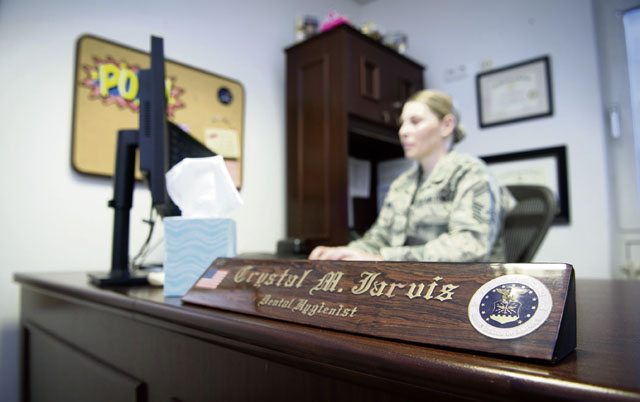
March 1 was a significant day not just for one Airman or for one squadron but for the U.S. Air Force.
On that day, “Shelly” Jarvis, 86th Dental Squadron superintendent, pinned on the rank of chief master sergeant — the first to do so in the U.S. Air Force as a dental hygienist.
“Becoming the first U.S. Air Force dental hygienist to earn the rank of chief master sergeant is humbling and extremely exciting,” said Jarvis. “It’s exciting because now dental hygienists know that it is possible to achieve something we thought was impossible for so long. The road is paved, and I am sure there will be many more to follow.”
Achieving this rank as a dental hygienist was previously thought to be impossible because of several factors.
There are only approximately 65 dental hygienists currently serving in the U.S. Air Force as a result of the dental hygiene field being a demanding and competitive one, requiring an education degree to be considered for a position within this profession.
Working as a dental hygienist has distinct and separate responsibilities from the other two professions found at the 86th DS, dental laboratory and dental assistant. Dental laboratory personnel are responsible for building and crafting many of the dental appliances required on a day-to-day basis. Dental assistants are responsible for logistics, customer service at the front desk as well as superficial dental cleaning.
Dental hygienists can give patients deep cleanings, anesthetic, and chart and monitor patients with ailments such as gum disease among other responsibilities. They can do many things a doctor in dentistry can perform except prescribe medication and perform irreversible actions such as putting a crown on a tooth.
Dental hygiene personnel attain rank relatively quickly up until master sergeant where impressive leadership skills can be hard to display within the career field. This is a result of the career field’s structure which necessitates seeing patients despite belonging to the senior noncommissioned officer core.
“We all know that attaining the rank of chief is extremely competitive and so one of the things that’s different about dental hygienists is that we see patients,” said Jarvis. “We’ll continue to see patients typically until senior master sergeant. In my case, as chief, I still see patients. We don’t take a normal leadership route. Many times we’re at a facility where we’re one person deep so we don’t get a lot of time to volunteer or take on leadership responsibilities because of the time commitment seeing patients requires. The breadth of experience can be limited in this career field.”
Jarvis did not allow these limitations to define her or the career field she belongs to.
“Put yourself in a position where you can be the person to change it,” said Jarvis. “If you have ideas about fixing things and you feel you’re not being heard, find your voice.”
Jarvis applied this mentality and saw things change for the better within the career field. When she put on the rank of master sergeant she took on the position as a dental hygiene consultant. One of the first changes she implemented was allow dental hygienists to be flight chiefs at select bases. This allowed dental hygienists to fulfill the leadership roles required to continue climbing the ranks within the enlisted force.
“I want to lead by example and I will continue to do that; I have two professions: the Profession of Arms and the Profession of Dental Hygiene, and I love them both. I am very committed to the Profession of Arms and I love what I do. I will continue to do this until I’m no longer effective.”
As soon as Jarvis put on the rank of chief master sergeant she knew she wouldn’t be the only dental hygienist to do so.
“I know I won’t be the last,” said Jarvis. “If not this year, then next year dental hygiene will see another chief master sergeant, I’m very confident in that. My one piece of advice for young Airmen is to continue living by the core values. If you truly embrace those and you’re honest with yourself, things will fall in place for you.”


